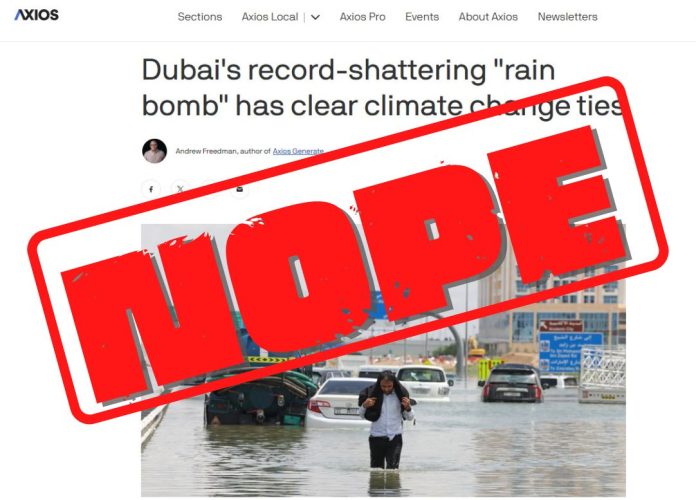An article written by Andrew Freedman, titled “Dubai’s record-shattering “rain bomb” has clear climate change ties,” published April 17th, in the online news website AXIOS makes the claim that record rainfall received in one day in the city of Dubai United Arab Emirates (UAE), has a clear connection to climate change. This is false. Not only is AXIOS conflating weather events with long term climate change, other evidence suggests this was little more than a rare weather event, which has happened before according to weather history for the area, and weak city drainage infrastructure was unable to handle the excess water.
The article notes the heavy rainfall and poor drainage stating:
- At least two years’ worth of rain, or about 6.26 inches, fell in just 24 hours, qualifying as what have come to be known colloquially as “rain bombs” for their ultra-heavy totals in such short periods of time.
- This amount of rainfall in a single day would cause problems even in more temperate locations, let alone Dubai, a desert city with poor drainage.
With over 6 inches of rain in a short time in a desert city that is not known for having infrastructure designed for large amounts of rain, it is not at all surprising that the drainage infrastructure could not handle an event like this, leading to street flooding. Freedman’s article goes on to say that the heavy rainfall event was forecasted by weather models:
The proximate cause of the flooding was a slow-moving and potent area of low pressure, or cold pocket of air aloft, that sparked complexes of severe thunderstorms over the United Arab Emirates and nearby countries on Tuesday.
This storm system, along with the threat of heavy rainfall, was shown by weather models several days in advance.
That is certainly true, for example in Figure 1 below, the ECMWF weather model output for April 16th shows significant rainfall for the area, with forecast color zones in excess of 6 inches.

Since the forecast showed significant rain over the area, UAE’s cloud seeding program apparently was put into action according to this article on Newsable:
Since the 1990s, the United Arab Emirates (UAE) has been actively engaged in cloud seeding efforts, overseen by the National Center of Meteorology (NCM). This government agency manages the country’s Rain Enhancement Program, utilizing a network of numerous weather stations to closely monitor atmospheric conditions for seeding operations.
Ahmed Habib, a specialist meteorologist at NCM, revealed to Bloomberg that seeding planes conducted seven missions over two days leading up to the heavy rainfall that inundated parts of the desert nation.
It seems like a simple case of a rare and intense short-term rainfall event, possibly juiced by cloud seeding. Since short-term weather models were used to forecast it, climate does not enter the picture. Long-term climate models could not have forecasted such an event because it is well below their time-scale of years to decades ahead.
Where Freedman’s article goes off the rails is with this claim:
Instead, climate science studies and observations around the world show that extreme rainfall events like this, including ones that break all-time records, are becoming more common and severe as the planet warms.
Moisture from the warm Persian Gulf fed into the thunderstorms in this case.
In fact, increased hydrological extremes, in both the form of drought and heavy rains, are one of the most robust ties to human-caused climate change, which is reshaping global weather patterns.
Freedman’s conflation of a single day weather event with long-term climate is his first error. Weather is not climate. Further, his claim on hydrological extremes is baseless, because the latest scientific report from Intergovernmental Panel on Climate Change (IPCC) shows clearly that there is no linkage to climate change at all. Figure 2 shows Table 12.12 on Page 90 – Chapter 12 of the UN IPCC Sixth Assessment Report. Emergence of Climate Impact Drivers (CIDs) in time periods shows this. The color corresponds to the confidence of the region with the highest confidence: white colors indicate where evidence of a climate change signal is lacking or the signal is not present, leading to overall low confidence of an emerging signal.
The section on heavy precipitation is highlighted in yellow. Note that the white spaces in the table for heavy precipitation indicate that such events have not emerged in the present, nor are they expected to emerge by 2050 in the context of long-term climate change. See the key at the bottom for the meaning of all colors.

Obviously, climate science does not support the claims made by Freedman and AXIOS about Dubai rainfall and flooding.
This shameful rush to judgment blaming climate change in the media is part of a pattern we have observed time and again here at Climate Realism. Almost without fail, when there is some oddball or unique weather event anywhere in the world, climate alarmists and the media immediately rush to blame it on climate change whether they have any facts to support it or not. Such behavior is irresponsible journalism.


















